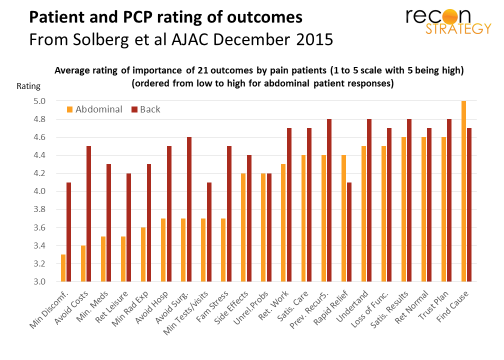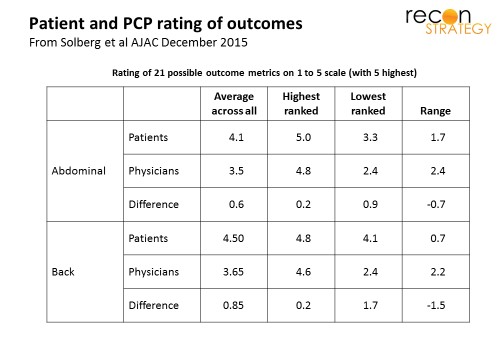Leif Solberg and team published research last month contrasting how patients value outcomes vs. how physicians think patients value outcomes. The approach was novel: they asked patients! They identified patients with an MRI or CT for abdominal or back pain and asked them (first in an open-ended way to identify 21 outcomes and then more systematically) to rate the importance of outcomes (e.g., find cause of pain, return to normal life functions, avoid surgery, etc.) on a 5 point scale (5=highest). They then asked PCPs to put themselves in the shoes of patients and rate the same outcomes. The exhibit below shows how patients on average rated the 21 outcomes:
The differences between patient and physician ratings are substantial: Patients rated almost all of the 21 outcomes higher than PCPs and generally valued the metrics in a narrower range implying less willingness to compromise (see exhibit). The differences were particularly stark for back pain patients:
And, while physicians and patients seem to agree on which outcomes were most/least important for abdominal pain (even if they assign different numerical values), they don’t agree very much at all for back pain. See exhibit:
You can say that physicians sort of “get” abdominal pain patients – they rate the same outcomes highest (“Find cause of pain”) and lowest (“Minimize test discomfort”); in fact, Figure 3 in the article shows a pretty high correlation across the 21 outcomes in terms of which ones were rated higher and lower. The same cannot be said for back pain patients. Not only do the highest and lowest rated outcomes look completely different, patients appear much less willing to make trade-offs across the outcomes than physicians (recall the narrow gap between highest and lowest valued outcomes for back pain patients – 0.7 vs. the large gap for physicians – 2.2).
Why might that be? In general, abdominal pain tends to be a bit higher acuity and more black and white in cause and cure while back pain is more frequently chronic with plenty of possible cures to be tried and failed (therapy, pain meds, surgery, more pain meds, etc.), potentially involving some physician shopping after each failure. (Note that for every 4 ED visits for abdominal pain, there is only 1 ED visit for back symptoms per CDC; however, one study estimates that ~10% of the US population suffers from chronic back pain vs. just 1% from chronic abdominal pain. It would seem, therefore, that a PCP would be seeing more back pain cases than abdominal pain cases)
Accordingly, physicians may be in a better position to set expectations with abdominal pain patients regarding what outcomes are important and what trade-offs should be made, resulting in a much higher correlation across relative ratings in outcomes. Back pain patients, however, may have gone through a couple changes in treatment strategy, a couple resettings on expectations and perhaps a couple physicians. Their understanding of physician explanations regarding clinical trade-offs may have become fuzzy or, lacking confidence in a durable cure, they are placing a lot more value on trusting the treatment plan (one of the top rated outcomes) and reducing the secondary consequences of intervention strategy (such as “minimizing medications”, “minimizing radiation exposure”, “avoiding hospitalization”, “minimizing discomfort”, “avoiding costs”, “avoiding surgery” – all outcomes where the difference between back patient values and physician values were the greatest). Physicians – not surprisingly focused on solving the clinical problem (highest rated outcome: “Find the cause of pain”) – risk coming across as transactional to these patients seeking a more trusting relationship.
It is intriguing that chronic back pain is much more common that chronic abdominal pain and therefore likely represents a more common problem which PCPs will see (recall for every chronic abdominal patient there are 10 chronic back pain patients). Lots of exposure does not seem to be helping physicians become more understanding.
Solberg and team have done a great service. How many experts have declared the importance of being patient-centered and then rattled off a set of jargon-cluttered metrics which they think patients care about but which few patients would even understand? More patient input and systematic testing needs to occur. (This is not to say, by the way, that patients are necessarily “correct” in their naive intuition – I think the fact that abdominal pain patients and physicians seem to largely agree on outcomes rating is largely a result of good patient education). And, while Solberg et al are concerned about the difficulty of benchmarking against some of these metrics, I suspect providers who invest now in figuring out what patients really want could see several advantages: Identifying and then rectifying expectations gaps can be tough across a complex system of front line care givers. Developing an ability to do this systematically could deliver a sustained advantage once the rest of the market catches on. Delivering the outcomes patients want more consistently (whether by meeting them or better managing them) could also result in better engaged patients today, potentially resulting in better outcomes and better economics for risk-taking providers.
Perhaps what we need is a remake of the Nancy Gibson classic “What Women Want” replacing the Mel Gibson character with a tanned, rested and ready Anthony Edwards (some may recall his signature role as ER’s Dr. Mark Greene) who suddenly can hear exactly what patients are thinking – and who becomes a much better physician as a result (and, perhaps, makes his ACO a bit of money along the way).



